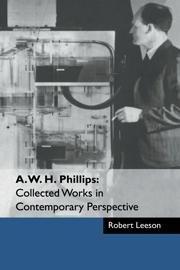Book contents
- Frontmatter
- Contents
- List of contributors
- Foreword by Arthur Brown
- Preface by Robert Leeson
- Part I Bill Phillips: Some Memories and Reflections
- Part II The Phillips Machine
- Part III Dynamic Stabilisation
- Part IV Econometrics
- 36 The Bill Phillips legacy of continuous time modelling and econometric model design
- 37 The published papers
- 38 The influence of A.W. Phillips on econometrics
- 39 An appreciation of A.W. Phillips
- 40 Some notes on the estimation of time-forms of reactions in interdependent dynamic systems
- 41 Cybernetics and the regulation of economic systems
- 42 The estimation of parameters in systems of stochastic differential equations
- 43 Estimation, regulation and prediction in interdependent dynamic systems
- 44 The Walras-Bowley Paper
- 45 Estimation of systems of difference equations with moving average disturbances
- 46 The estimation of continuous time models
- 47 Estimation in continuous time series models with autocorrelated disturbances
- 48 Efficient fitting of rational spectral density functions and transfer functions
- 49 The Lucas Critique: did Phillips make a comparable contribution?
- 50 Models for the control of economic fluctuations
- 51 Statistical estimation for the purpose of economic regulation
- 52 The last paper: a foreshadowing of the Lucas Critique?
- References
- Index of names
- Index of subjects
43 - Estimation, regulation and prediction in interdependent dynamic systems
Published online by Cambridge University Press: 04 May 2010
- Frontmatter
- Contents
- List of contributors
- Foreword by Arthur Brown
- Preface by Robert Leeson
- Part I Bill Phillips: Some Memories and Reflections
- Part II The Phillips Machine
- Part III Dynamic Stabilisation
- Part IV Econometrics
- 36 The Bill Phillips legacy of continuous time modelling and econometric model design
- 37 The published papers
- 38 The influence of A.W. Phillips on econometrics
- 39 An appreciation of A.W. Phillips
- 40 Some notes on the estimation of time-forms of reactions in interdependent dynamic systems
- 41 Cybernetics and the regulation of economic systems
- 42 The estimation of parameters in systems of stochastic differential equations
- 43 Estimation, regulation and prediction in interdependent dynamic systems
- 44 The Walras-Bowley Paper
- 45 Estimation of systems of difference equations with moving average disturbances
- 46 The estimation of continuous time models
- 47 Estimation in continuous time series models with autocorrelated disturbances
- 48 Efficient fitting of rational spectral density functions and transfer functions
- 49 The Lucas Critique: did Phillips make a comparable contribution?
- 50 Models for the control of economic fluctuations
- 51 Statistical estimation for the purpose of economic regulation
- 52 The last paper: a foreshadowing of the Lucas Critique?
- References
- Index of names
- Index of subjects
Summary
Summary
The statistical analysis of interdependent dynamic systems has developed separately in different fields of study, particularly in control engineering and in economics. Control engineers have usually formulated their theories in terms of differential equations, giving careful attention to continuously distributed lagged dependencies and other forms of dynamic relationship. Economists have tended to formulate their theories in terms of difference equations, partly because some discrete adjustments do occur in economic systems but often for the less satisfactory reason that their observations are taken at discrete points of time or over discrete time intervals. Both continuous and discrete systems are considered in this chapter. In econometric work predictions are often made of the future values of certain variables in the economic systems, on the assumption that the system and the stochastic properties of the disturbances to it remain unchanged. In both control engineering and economics it is usually more useful to consider conditional predictions on various assumptions concerning the values of those variables which are subject to direct control, or predictions about the changes in the operating performance of the system which would result from a modification of its structure. Such predictions require knowledge of the structural equations and so raise the problems of estimation and identification. In both continuous and discrete systems the problem of identification will often be overcome if careful attention is given to the formulation of the basic model as a system of dynamic behaviour relationships.
- Type
- Chapter
- Information
- A. W. H. Phillips: Collected Works in Contemporary Perspective , pp. 408 - 418Publisher: Cambridge University PressPrint publication year: 2000
- 2
- Cited by



